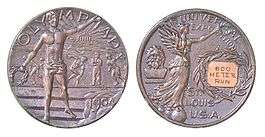Dieges & Clust
Dieges & Clust were jewellers established in New York[1][2] in 1898 by Col. Charles J. Dieges (b. Oct. 26, 1865-d. Sept. 14, 1953) and Prosper Clust.[1]

They produced many medals, including the Spanish–American War Medal, the 1904 Olympic Medal, the Eagle Scout medal (from 1916–1920),[3] the Medal of Honour, and the Titanic-Carpathia Medals (at the request of "The Unsinkable" Mrs. Molly Brown). They made baseball's first Most Valuable Player Awards and many Baseball Press Pins as well as Lou Gehrig's farewell plaque. They also cast the Heisman Trophy (in New York and later Providence, Rhode Island) from its inception in 1935 through late 1979 when the company was sold to Herff Jones (a division of Carnation) on January 1, 1980.[4]
Perhaps the height of Dieges & Clust's production were the 1920s trophies known in sports collecting circles as "The Five Figural Spalding Baseball Trophies". The various trophies depict a baseball player pitching, catching, batting, playing first base, or playing in the outfield. The proportions of the figures and the detail (of the faces, fingers, stitching in the baseball gloves and shoelaces) are remarkable. They fetch up to $5,000 at auction, relatively high for a silver-plated trophy on a wooden base.
The company produced the Martin J. Sheridan Medal for Valor for the New York Ciy Police Department (NYPD) that was established in honor of Detective Martin J. Sheridan – the Irish-American Athletic Club’s star U.S. Olympic champion who died in 1918 of the influenza pandemic. The medal was first presented in 1922 and regularly awarded until discontinued in 1975. The medal was initially paid for through a trust fund established by the Martin J. Sheridan Memorial Committee, with New York State Supreme Court Justice Daniel F. Cohalan serving as chairman.[5]
A 1936 New York Yankees World Series ring cast by Dieges & Clust and owned by Lou Gehrig held the record sale price for such a ring at $17,500.[6]
In 1999, Sotheby's sold what was believed to be Lou Gehrig's 1927 ring for $96,000.
References
- Alan S. Katchen (1 April 2009). Abel Kiviat, National Champion: Twentieth-Century Track & Field and the Melting Pot. Syracuse University Press. pp. 167–. ISBN 978-0-8156-0939-1. Retrieved 13 September 2012.
- "Dieges and Clust". Harvard Collection of Historical Scientific Instruments. Retrieved February 10, 2017.
- "Dieges and Clust 1916-1919". eaglescoutbadge.com. Retrieved September 13, 2012.
- Breed, Donald (January 16, 2005). "Beating the field - Herff Jones, maker of the Heisman Trophy, thrives on class-ring sales". Providence Journal. Retrieved September 14, 2012.
- Ian McGowan. "Recipients of the New York City Police Department's Martin J. Sheridan Medal for Valor". Retrieved June 18, 2020.
- Joselow, Froma (April 22, 1986). "Providence firm gets contracts for '87 service academy rings Herff Jones Co. sweeps the competition". Providence Journal. Retrieved September 13, 2012.